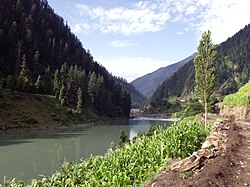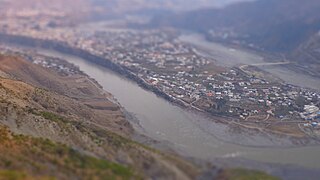Jhelum River
| Jhelum | |
|---|---|
 Jhelum River photographed in Pakistan, c. 2006 | |
| Location | |
| Countries | India, Pakistan |
| Physical characteristics | |
| Source | |
| • location | Verinag Spring |
| • coordinates | 33°32′05″N 75°14′59″E / 33.53472°N 75.24972°E |
| Mouth | |
• location | Chenab River at Trimmu, Jhang District |
• coordinates | 31°10′N 72°09′E / 31.17°N 72.15°E |
| Length | 725 km (450 mi) |
| Discharge | |
| • average | 1,026.6 m3/s (36,250 cu ft/s) (near Mangla Dam) |
| • minimum | 234.19 m3/s (8,270 cu ft/s) (near Mangla Dam) |
| • maximum | 26,419.13 m3/s (932,983 cu ft/s) (near Mangla Dam) |
| Discharge | |
| • average | 313.19 m3/s (11,060 cu ft/s) (near Domel) |
| Discharge | |
| • average | 229.20 m3/s (8,094 cu ft/s) (near Baramulla) |
| Basin features | |
| River system | Indus River |
| Tributaries | |
| • left | Poonch River, Sukhnag River |
| • right | Arpath River, Lidder River, Kishanganga River/Neelum River, Sind River, Kunhar River, Pohru River, Erin River |
The Jhelum River[a] is a river in the northern Indian subcontinent. It originates at Verinag and flows through the Indian-administered territory of Jammu and Kashmir, into Pakistan-administered Azad Kashmir, then the Pakistani province of Punjab. It is the westernmost of the five rivers of the Punjab region, and flows through the Kashmir Valley. It is a tributary of the Chenab River and has a total length of about 725 kilometres (450 mi).[6]
Etymology
[edit]
A Pakistani author, Anjum Sultan Shahbaz, recorded some stories of the name Jhelum in his book Tareekh-e-Jhelum:
'Many writers have different opinions about the name of Jhelum. One suggestion is that in ancient days Jhelumabad was known as Jalham. The word Jhelum is reportedly derived from the words Jal (pure water) and Ham (snow). The name thus refers to the waters of a river (flowing beside the city) which have their origins in the snow-capped Himalayas.[7]
The Sanskrit name for the river is Vitástā, derived from an apocryphal[citation needed] legend regarding the origin of the river in the Nilamata Purana. The name survives in the Kashmiri name for this river, Vyath and in Punjabi (and more commonly in Saraiki[8]) as Vehat.[9] It was called the Hydaspes by the armies of Alexander the Great.[10]
History
[edit]
The river Jhelum was originally recognized by the name Vitasta. The river was called Hydaspes (Greek: Ὑδάσπης) by the ancient Greeks.
Alexander III of Macedon and his army crossed the Jhelum in BCE 326 at the Battle of the Hydaspes River, where he defeated an Indian king, Porus. According to Arrian (Anabasis, 29), he built a city "on the spot whence he started to cross the river Hydaspes", which he named Bukephala (or Bucephala) to honour his famous horse Bucephalus, buried in present-day Jalalpur Sharif. It is thought that ancient Bukephala was near the site of modern Jhelum.[citation needed] According to Gujrat district historian Mansoor Behzad Butt, Bukephalus was buried in Jalalpur Sharif, but the people of Mandi Bahauddin, a district close to Jehlum, believed that their tehsil Phalia was named after Alexander's dead horse, saying that the name Phalia was a distortion of Bucephala.
The waters of the Jhelum are allocated to Pakistan under the terms of the Indus Waters Treaty. India is working on a hydropower project on a tributary of Jhelum river to establish first-use rights on the river water over Pakistan as per the Indus Waters Treaty.[11]
Legends
[edit]
According to Hindu puranas, the goddess Parvati was requested by the sage Kashyapa to come to Kashmir to purify the land from the evil practices and impurities of the pishachas living there. Parvati assumed the form of a river in the netherworld. Her consort Shiva struck with his spear near the abode of Nila, (Verinag spring). With this stroke of the spear, Parvati emerged from the netherworld. He excavated a ditch measuring one vitasti using the spear,[12] through which the river, originating from the netherworld, came out, and so he gave her the name Vitástā.[13]
The ancient Greeks also regarded the river as a god, as they did most mountains and streams. The poet Nonnus in the Dionysiaca[14] calls the Hydaspes a titan-descended god, the son of the sea-god Thaumas and the cloud-goddess Elektra, the brother of Iris, goddess of the rainbow, and half-brother to the harpies, the snatching winds. Since the river is in a foreign country, it is not clear whether they named the river after the god, or whether the god Hydaspes was named after the river.
Course
[edit]The river Jhelum rises from Verinag spring at the foot of the Pir Panjal in the southeastern Kashmir Valley administered by India. It is joined by its tributaries
- Lidder River near village Mirgund at Khanabal
- Veshaw River at Sangam in Anantnag
- Sind River at Shadipora
- Pohru River at Doabgah in Sopore, Jammu and Kashmir.
It flows through Srinagar and Wular Lake before entering Pakistan-administered Kashmir through a deep narrow gorge. The Kishanganga River/Neelum River, the largest tributary of the Jhelum, joins it at Domel, Muzaffarabad, as does the next largest, the Kunhar River of Kaghan Valley. It is then joined by the Poonch River, and flows into the Mangla Dam reservoir in the Mirpur District. The Jhelum enters Pakistani Punjab in the Jhelum District. From there, it flows through the plains of Pakistan's Punjab, forming the boundary between the Jech and Sindh Sagar Doabs. It ends in a confluence with the Chenab River at Trimmu in the Jhang District. The Chenab merges with the Sutlej to form the Panjnad River, which joins the Indus River at Mithankot.
Most of the villages and important cities of Kashmir valley are situated on the banks of Jhelum.[15]
Lakes
[edit]Dams, barrages and bridges
[edit]The river has rich power generation potential in India. Water control structures are being built as a result of the Indus Basin Project, including the following:
- Mangla Dam, completed in 1967, is one of the largest earth-fill dams in the world, with a storage capacity of 5,900,000 acre-feet (7.3 km3)
- Karot Hydropower Project is an under-construction[when?] concrete-core rockfill gravity large dam in Pakistan, with a planned installed capacity of 720 MW.
- Rasul Barrage, constructed in 1967, has a maximum flow of 850,000 ft³/s (24,000 m³/s).
- Trimmu Barrage, constructed in 1939 some 20 km from Jhang Sadar at the confluence with the Chenab, has maximum discharge capacity of 645,000 ft³/s (18,000 m³/s).
- Victoria Bridge, Haranpur, constructed in 1973, approximate 5 km from Malakwal near Chak Nizam village. Its length is 1 km, mainly used by Pakistan Railways, but there is a passage for light vehicles, motorcycles, cycles and pedestrians on one side.
- Uri Dam with 480 MW Hydroelectric station is located in Baramulla district of Jammu and Kashmir.[16]
- Uri Dam II with 240 MW Hydroelectric station is also located in Baramulla district of Jammu and Kashmir.[17]
- Kishanganga Hydroelectric Plant with 330 MW Hydroelectric station is located in Bandipora district of Jammu and Kashmir.[18]
Canals
[edit]- Canals in and around the city of Srinagar.
- The Upper Jhelum Canal runs from Mangla Dam to the Chenab.
- The Rasul-Qadirabad Link Canal.
- The Chashma-Jhelum Link Canal runs from the Chashma Barrage on the Indus River to the Jhelum river downstream of Rasul Barrage. This is 40 kilometres (25 mi) from Mari Shah Sakhira town.
Gallery
[edit]-
Jhelum river, Baramullah, Kashmir, 1880s
-
Jhelum River c. 1900; photo taken by Eugene Whitehead Esq.
-
Rope Bridge at Karli, 1908
-
Bridge over the river, Srinagar, 1969
-
Jhelum river near Muzaffarabad (2014)
-
File:River Jehlum, Muzaffarabad
-
Near Muzaffarabad, 2014
-
The Jhelum at Verinag, 2014
-
Jhelum River at Jhelum City, 2005
See also
[edit]Notes
[edit]- ^ Urdu pronunciation: [dəɾˌjɑː.e d͡ʒeɦˈləm], Saraiki pronunciation: [veˈɦət̪ dəɾˌjɑː]; Punjabi pronunciation: [d͡ʒéˈlɐm / véːt̪ᵊ nəˈd̪iː], Kashmiri pronunciation: [ʋʲatʰ dərʲjaːʋ]
References
[edit]- ^ The Quarterly Review. Murray. 1816. p. 170. Archived from the original on 16 July 2023. Retrieved 17 March 2017.
- ^ Bakshi, S. R. (1997). Kashmir Through Ages. Sarup & Sons. p. 110. ISBN 9788185431710. Archived from the original on 16 July 2023. Retrieved 17 March 2017. Five volumes.
- ^ Rapson, E. J. (9 June 2011). Ancient India: From the Earliest Times to the First Century AD. Cambridge University Press. p. 171. ISBN 9780521229371. Archived from the original on 16 July 2023. Retrieved 1 November 2020.
- ^ Naqvi, Saiyid Ali (November 2012). Indus Waters and Social Change: The Evolution and Transition of Agrarian Society in Pakistan. Oxford University Press Pakistan. p. 10. ISBN 9780199063963. Archived from the original on 16 July 2023. Retrieved 17 March 2017.
- ^ Know Your State: Jammu and Kashmir. Arihant Publications (India) Ltd. November 2012. p. 35. ISBN 9789313169161. Archived from the original on 7 April 2022. Retrieved 6 November 2021.
- ^ "Jhelum River". Encyclopædia Britannica. Archived 1 May 2015 at the Wayback Machine. Retrieved on 4 October 2013.
- ^ Shahbaz, Anjum Sultan (2003). Tārīkh-i Jihlam (in Urdu). Main Bazar, Jhelum: Buk Kārnar [Book Corner]. OCLC 60589679.
- ^ "Punjab Portal". Retrieved 12 June 2024.
or Vehat, the latter name being more common towards the south of the district.
- ^ Soofi, Mushtaq (20 November 2015). "Punjab Notes: Vehat: where great warriors clashed". DAWN.COM. Retrieved 12 June 2024.
- ^ Locke, Ralph P. (2016). "Alexander the Great and the Indian Rajah Puru. Exoticism in a Metastasio Libretto As Set by Hasse and by Handel". Revue de Musicologie. 102 (2): 275–317. ISSN 0035-1601. JSTOR 44739484.
The elephants of Puru's army were overwhelmed by the Greeks' horses in 326 BC on the left bank of the Hydaspes, a river - also known as the Jhelum or Jhelam - that is located in what is today Pakistan
- ^ "India fast-tracks work on Jhelum river hydroelectric power project". Archived from the original on 3 June 2010. Retrieved 25 May 2010.
- ^ (a particular measure of length defined either as a long span between the extended thumb and little finger, or as the distance between the wrist and the tip of the fingers, and said to be about 9 inches
- ^ Nilamata Purana English Translation by Dr. Ved Kumari Ghai, verses 247–261.
- ^ section 26, line 350
- ^ "District Survey Report On Kashmir" (PDF). District Survey Report. Archived (PDF) from the original on 14 February 2022. Retrieved 13 February 2022.
- ^ "NHPC Limited : Projects : Power Stations : Uri – I". www.nhpcindia.com. Archived from the original on 5 April 2022. Retrieved 14 February 2021.
- ^ "NHPC Limited : Projects : Power Stations : Uri-II". www.nhpcindia.com. Archived from the original on 30 October 2019. Retrieved 14 February 2021.
- ^ "NHPC Limited : Projects : Power Stations : Kishanganga". www.nhpcindia.com. Retrieved 14 February 2021.
External links
[edit]- Livius.org pictures of the Hydaspes Archived 14 October 2013 at the Wayback Machine













